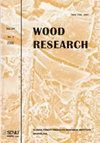纸浆造纸中桦树皮平衡中白桦素的提取。
IF 1
4区 农林科学
Q3 MATERIALS SCIENCE, PAPER & WOOD
引用次数: 4
摘要
技术树皮被用来获得桦木蛋白;纸浆和纸张生产中的平衡问题。树皮是通过在研磨作用和分级的破碎机上研磨制备的,因此,获得了主要的级分:小于1mm(35.4%),从3到4.5mm(31.5%)。在研磨过程中,树皮被分离,粗级分中以树皮为主,细级分中有韧皮部。为了进行比较,通过手工切割获得了各种尺寸的桦树皮模型样品。采用乙醇超高频萃取法对桦树皮组分和模型桦树皮样品进行了化学处理。生槟榔是从提取物中沉淀出来的。从绝对干燥的原料中提取物质和粗槟榔素的产率分别为12.1-21.9%和5.1-16.7%;最大产量来自树皮的粗糙部分或来自具有较小颗粒尺寸的模型样品。作者研究了树皮部分和桦树皮样品的SHF提取时间对提取物质产率的影响。树皮组分的最佳提取时间为10分钟,桦树皮为15分钟。采用高效液相色谱法测定了所获得的槟榔原料样品的定量含量。样品中三萜类化合物的总含量约为80%,桦木素的含量在70.3 72.1%之间,来自提取物的绝对干燥物质。与其他部分相比,树皮的粗部分含有更多的主要成分。建议使用树皮的细部分作为酚类物质的来源。本文章由计算机程序翻译,如有差异,请以英文原文为准。
Extraction of betulin from the birch bark balance at pulp and paper production.
The technical bark was used to obtain betulin; the one which is a barking of birch balance at pulp and paper production. The bark was prepared by grinding it on a crusher of abrasive action and fractionating, thus, the main fractions were obtained: less than 1 mm (35.4%), from 3 to 4.5 mm (31.5%). The bark was separated during the grinding process, the bark prevails in the coarse fraction, while bast is found in the fine fraction. For comparison, model samples of various sizes of birch bark were obtained by hand cutting. Chemical processing of bark fractions and model birch bark samples were carried out by the use of super-high frequencies (SHF) extraction with ethyl alcohol. Raw betulin was settled from extracts. The yield of extractive substances and raw betulin was 12.1-21.9% and 5.1-16.7% from absolutely dry raw materials; the maximum yield was from a coarse fraction of the bark or from model samples with smaller particle sizes. The authors studied the kinetics of the yield of extractive substances depending on the duration of SHF-extraction for bark fractions and birch bark samples. The optimal duration of the extraction for bark fractions is 10 min, and for birch bark is 15 min. The quantitative content was determined by the high performance liquid chromatography (HPLC) method for the obtained samples of betulin raw material. The total content of triterpenoids in the samples is about 80%, the betulin share is between 70.3 72.1%, from the absolutely dry substances of the extract. Coarse fraction of the bark contains more of the main component as compared to other fractions. It is advisable to use the fine fraction of the bark as a source of phenolic substances.
求助全文
通过发布文献求助,成功后即可免费获取论文全文。
去求助
来源期刊

Wood Research
工程技术-材料科学:纸与木材
CiteScore
2.40
自引率
15.40%
发文量
81
审稿时长
5.4 months
期刊介绍:
Wood Research publishes original papers aimed at recent advances in all branches of wood science (biology, chemistry, wood physics and mechanics, mechanical and chemical processing etc.). Submission of the manuscript implies that it has not been published before and it is not under consideration for publication elsewhere.
 求助内容:
求助内容: 应助结果提醒方式:
应助结果提醒方式:


